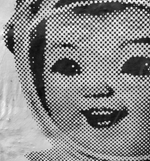It was dark, so dark, so claustrophobic and there were too many bodies. It was overwhelming. I might have accidentally touched the bum of a revered WMA. I stamped on someone’s Nikes, while I used their head to stop myself from falling. We held hands as we slithered through narrow passageways into a series of rooms featuring videos which were at once exasperating, frightening, beautiful and mesmerizing. Bodies everywhere. Bodies crammed. Uncomfortable bodies. Each time I needed to breathe I ended up in a white room. After the final calm of the white cube, we left ducking and diving through the sprawling crowd, down the steps and onto Karangahape road.
The Shadow Of The Dome of Pleasure is an experiential exhibition of moving image works intended to consolidate both poetic and filmic languages into a series of gestures that disrupt the staticity of an image. This exhibition rejects the notion that the audience is not implicated when viewing art — specifically with moving images. The audience must physically move through the dizzying space, which when crowded can become very claustrophobic. However, as each film becomes overwhelming or tiring one can simply move through the labyrinth to the next location, or step out into an existentially loaded white cube to contemplate and regenerate.
Upon entering, patrons become aware of an attention to detail and considered approach which lend great subtlety to this exhibition. The entrance is adorned with an unassuming and purposeless silk silver curtain. It calls to mind the faux opulence experienced in both theatres and cinemas, which are a kind of temple to the aura of the moving image and thereby sanctuary for the performativity of identity and language. Each of the video works is experienced through a darkened maze constructed by Alexander Laurie and Biljana Popovic in conversation with curator, Henry Davidson. Working in collaboration, Popovic and Laurie Davidson expand the role of curator from one who simply chooses where works are placed in a room. Instead, the construction of this space became a consideration of how bodies are directed within a space, much in the same way a director would work with a series of actors, set designers and lighting engineers etc. The labyrinth recalls a sex dungeon or peep show with each work being assigned its own “room” and creating a circuit of vignettes, yet it is also strongly reminiscent of the green room in a theatre. The show explores notions of desire but it would be reductive and even offensive to conflate this wholeheartedly with homoerotic sexual desire. This comes with the understanding of the historical and contemporary relationship between Artspace and Karangahape road and even to the act of cruising, but to reduce The Shadow of the Dome Pleasure to a show only focused on sex is to miss the point.
During the opening for this show, I found myself constantly feeling a panic of anxiety and retreating to the white cube. The space was cluttered by bodies blinded in the darkness and searching for a way through. This maze structure interrupted the mundanity of the white cube and exhibition display, creating an immersive sensory experience. It holds a series of video works that have very disparate but congruent concerns around sexuality, gender, identity and relationships both with one’s self and others. The immersive internal maze structure and strong theoretical underpinnings are reminiscent of Thierry Chaput and Jean-François Lyotard’s Les Immatériaux exhibition at Centre Georges Pompidou in Paris in 1985 for which they created a darkened sensorium structure to explore academic concerns through art. The structural display of video works is also reminiscent of The Brain currently on show at Te Uru curated by Christina Read, with its spatial structure by Paul Cullen that maps out each video work in a network of metal frames connecting “academic and amateur concerns.” There are crossovers between works in terms of sound with the central navigation point of the maze as a white cube, a calming and an almost “angelic” relief from the thrilling anxiety of the labyrinth. The white cube is slick and polished with the audio seeping in from all films — allowing it to be a contemplative space to digest the overwhelming maze experience. It is an existential nightmare, a matrix that is a simultaneous reprieve and a collapse of The Shadow Of The Dome Pleasure. Having the white space in the centre one couldn’t help but notice the gravitational pull towards the safety of the white cube. The irony being that it seems emblematic of the rat race of the art world, which is noted through the amount of Nike Frees one can count at any art opening. The scale of the white padded room left one feeling like a rat in this fantasy space, which also called to mind that of an asylum cell, with the padded walls somehow providing much needed comfort. Yet perhaps it is comforting because you are not trapped in this whiteness. The Shadow Of The Dome Pleasure invites its audience to be uncomfortable, yet transfixed by its lyrical hysteria.
The labyrinth’s path begins with Blow Job (1964) a seminal work by Andy Warhol, which is shown on 16mm. The title of this work is the one true indicator of what the action within the video entails, the viewer has to assume based around the title of the work. It features a young man’s expression with his lips moving together and apart in pleasure. It is not stated whether he is receiving a blow job from a man or a woman. It highlights the power of the viewer to mitigate the experience of looking and the various connotations of meaning, which are inherent within the hierarchy of language. The “actor,” DeVeren Bookwalter, looks vulnerable as he responds to this desire and it is novel to see a man placed under a sexualized gaze, in contrast to the obligatory and often contrived performed desire by women within film and moving image history. The gaze is turned on him voyeuristically to the point where the work carries a certain degree of uneasiness from the viewer. This moving image has no sense of bodily autonomy and yet it is belied by Warhol’s own sexual ambiguity, as well as his history of openly exploiting people, particularly his superstars. The projector has to be re-reeled as it plays on a loop for 35 minutes, a now endearing nostalgic feature of redundant technology. The film is silent, yet the projector ticks indicating a rhythm or pace to which you can move through the exhibition. The inclusion of this work anchors the greater concerns of the show, which are traceable through the art historical lineage of video art.
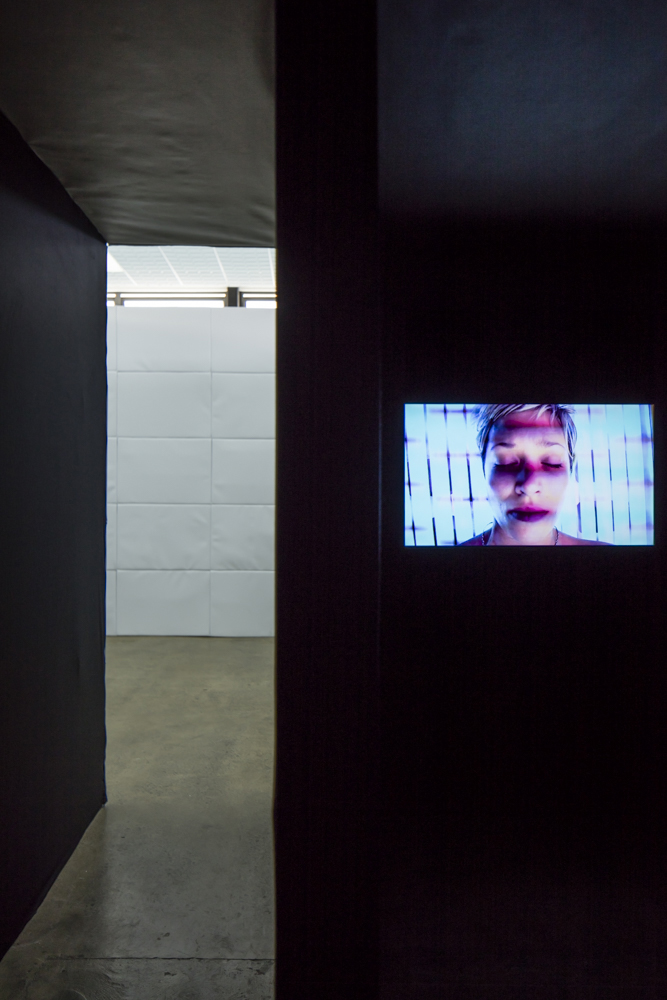
In stark contrast to Blow Job the viewer and performer relationship is inverted with Jesse Darling’s work. Darling is a proto digital artist concerned with the power of images and the gaze. Lil Icarus (2013) is a video selfie of them in a tanning booth. Lights flicker behind them in a futuristic manner while an audio soundtrack of sound bite tweet style existential dialogue morphed with capitalist mantras loops. In this video Darling is an autonomous subject representing their own subjectivity. The so-called “selfie generation” has the ability to represent the complexities of its existence through the use of technology in a manner that is empowering and disrupts the way in which bodies are fetishized as objects within western hetero-patriarchal society, highlighting the dichotomy of being both subject and object. The selfie acts as a tool that is both poetic and theatrical.
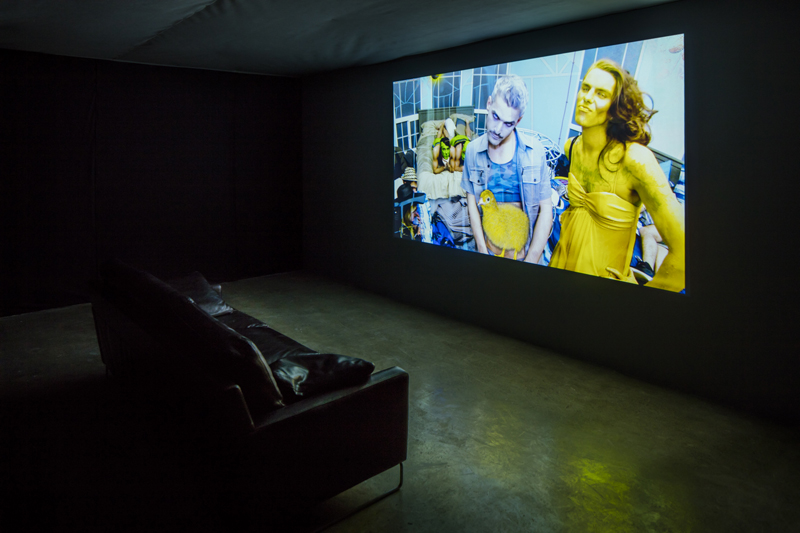
Trecartin’s work Item Falls (2013) is a rhythmically layered consideration of the way images function and are disseminated in our proto-digital world. Trecartin’s work is a mimicry of the overproduction and -consumption of moving images. Item Falls plays with notions of Brechtian Verfremdungseffekt or alienation through the reminder to the audience that a performance can be a representation of reality, but not reality itself. Trecartin addresses youth cyber culture by mirroring the tempo and repetitive nature of information both online and offline. Performers appear in animation, confess and sing to an interpellated webcam. Every image or scene is interrupted or coexists with an additional image. Where one narrative ends, another begins and loops back on itself in a self-referential spiral, satiating the tempo of the digital natives cognition. Trecartin uses semiocapitalism, the overproduction of signs, cleverly. In the context of this show, it addresses capitalism’s place in the history of moving images. Item Falls addresses a contemporary desire through the overproduction of visual signs to communicate. Each performer is attempting to express an existential hysteria under capitalism through a constant stream of data. Holding a camera a character says, “The last time someone threw money at me I was so upset that I was offended.” Though this work is fast-paced and complexly fractured, to describe Trecartin’s work as reflecting a “schizophrenic” character of the moving image is illogical and offensive, as that is a serious mental illness and not a descriptor term. At one point during this work, a number of chickens appear, which seemingly refers to John Waters’ Pink Flamingos (1972) in terms of its absurdity and abjection.
Item Falls, as with much of Trecartin’s wider practice and collaboration with artist Lizzie Fitch, has an aesthetic semiotically located in California, marked by its setting in prefab mansion interiors, red plastic party cups, strip-mall signs and high-school football jumpers — signs of the visual discourse outpouring from America through its dominating media industry.
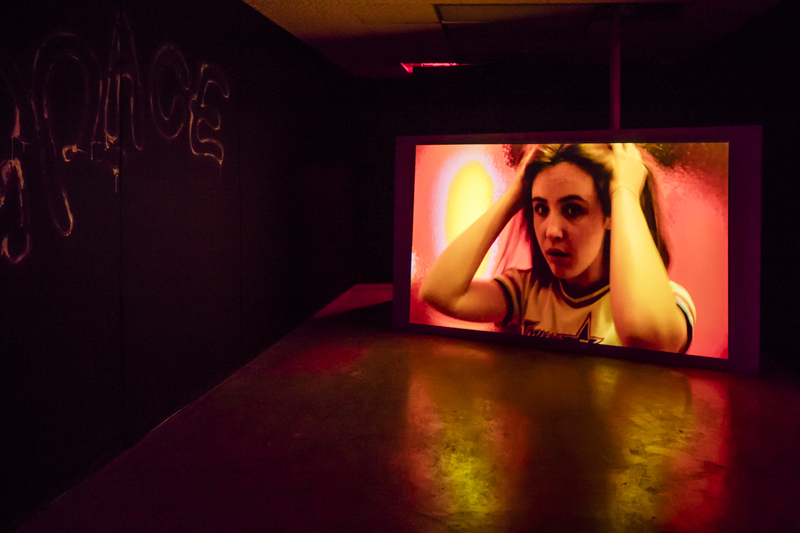
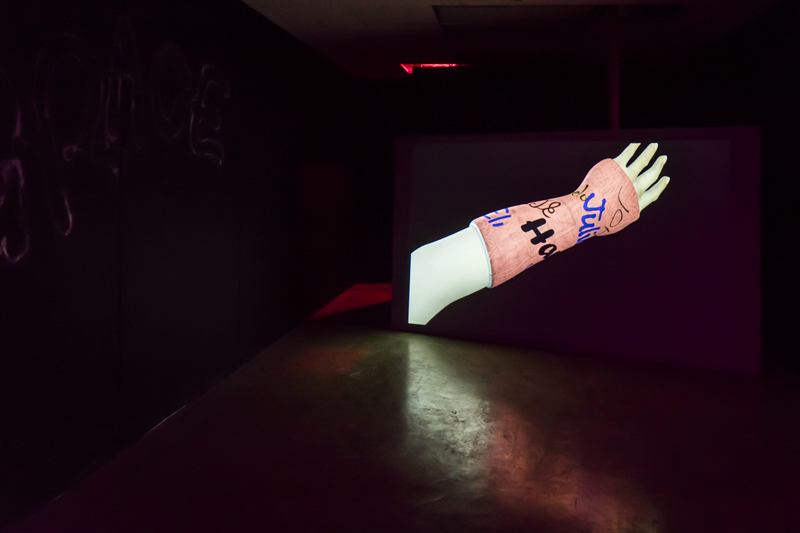
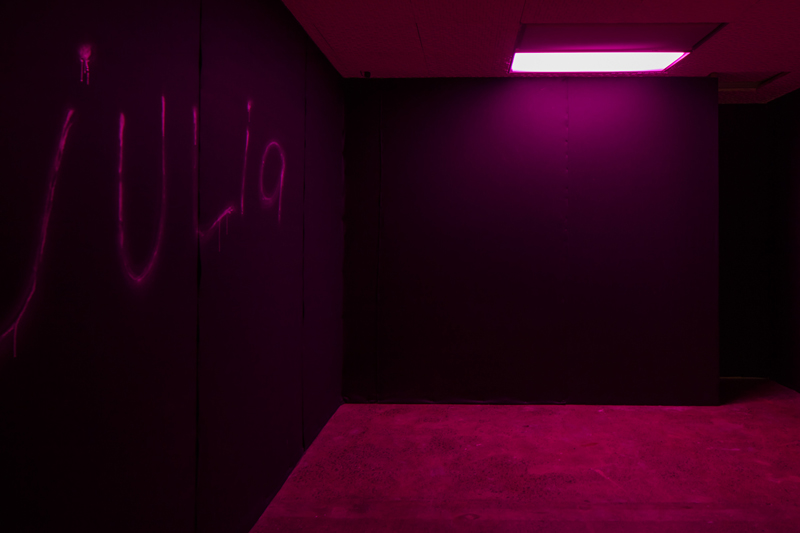
Juliet Carpenters’ Ingénue (2015) is the only commissioned work, which consists of a video of a young actress reciting a text, in between a distant haze of rain through a motorway system and a series of other imageries, including sword swallowing. The space in which Ingénue is shown features two pink lights, one within the viewing space and one in the small corridor as one leaves. The latter reveals the exposed hardwiring of the space. The use of pink lighting seems to evoke a naivety, yet again seems to allude to theatres and behind-the-scenes elements of theatre and the moving image. It conjures up the memory of Davidson’s previous curatorial exhibit, Campaign Furniture (2013) which highlighted all the institutional features of the Dunedin public art gallery and denounced the neutrality of white cube spaces. Its disrupts the fantasy of film. The video is displayed on purpose-built screen with the names “Julia” and “Grace” spray painted on either side of the wall. Ingénue translates as “young actress” or a “new young actress” or one that is typecast as such. The ingénue is framed as being beautiful, naïve and in some kind of mental or emotional danger, or even physical danger. Ingénue is much like a screen test and the actress’s vulnerability — as well as a number of aesthetic cues — is reminiscent of Warhol’s self-portrait of tragic factory superstar Edie Sedgwick.
While performing this monologue, the actress’s vocal delivery is an advocation for emotion and tenderness; she does not regulate her emotional outpouring. In a culture that rewards toxic masculinity through which coldness, aggression and machine-like behavior are valued, being an advocate for tenderness is a powerful alternative to hardening in the face of society’s bullshit. It also seems to incite and express the theory of the post-wounded woman, in which writer Leslie Jamison states that, “The wounded woman gets called a stereotype, and sometimes she is. But sometimes she’s just true. I think the possibility of fetishizing pain is no reason to stop representing it. Pain that gets performed is still pain. Pain turned trite is still pain.”
Her voice oscillates between being raw, hysterical, calm, amused and uncomfortably earnest. All the while the work cracks at the edges of the unreal realm of moving image. Unlike other ingénues, the actress in Carpenters’ work doesn’t need saving and describes her incongruent emotional state through her monologue. This monologue begins with the crop marks, as it slowly focuses upon the actress’ face and the focusing of lighting followed by the fleeting presence of the “REC” text. The mark of the “REC” speaks to Carpenters’ interest in both current digital technologies and pre-digital or dated technologies. Her video work obfuscates the differentiation between these technologies.
Next in the cycle, The End of Time by Akram Zaatari represents the ritual of connection and intimacy as constructed in film and television. Three men alternately stand opposite one other and perform the stunted tropes of intimacy in a sterile room much like Popovic and Laurie’s white cube. They speak, they undress, they reject advances and they embrace. Zaatari opens an existential conversation on the role bodies and social codes play in intimacy and desire on film. The performers never close their embraces, when they embrace they do not kiss as we expect them to and they seem emotionally unaffected by their exchanges. Zataari leads one to ask whether the construction of desire and intimacy on film has a pedagogic effect on desire and intimacy out of the cinematic world. Are we passively mimicking strained rituals and fooling ourselves that they allude to further meaning or significance?
Zaataris’ work leads on to Agnieszka Polska’s Future Days. Future Days depicts a limbo-esque fantasy space inhabited by roaming actors in latex masks playing the roles of deceased artists Paul Thek, Jerry Ludwiniski, Charlotte Posenenske, Andrzej Szewczyk, Lee Lozano and Bas Jan Ader. This work is very uncomfortable to engage with, as in our experience the use of latex masks isunnerving. This is due to the expressionless faces of each artist staring out at the viewer in a kind of stilted, stunted play. There is a disconnect between dialogue and the movement of these characters. Each ponders their existence on Earth and within this other space. In the scenes by the sea, one thought of Jan Ader sailing into oblivion, never to be seen again. This work is layered in art-historical references. Robert Smithson’s land-art work Partially Buried Wood Shed (1970) appears, with the artists recoiling out of it while some stand on top. There is then a dialogue around the disintegration of this work. Smithson’s land art works always make me think of his masculinity in relation to Ana Mendieta — who died tragically in 1985 — especially Mendieta’s dismissal of the toxically masculine and neocolonial act by Smithson of pouring concrete into the earth for Spiral Jetty. Future Days makes an inference to the tragic irony of art, which tries to live forever, and the mythicizing of artists after they have died. The work represents a kind of mythical contemplative space where the artists appear trapped inside the pleasure dome searching for existential answers.
The Shadow of the Dome of Pleasure traces the history of desire within art, film and wider visual discourse. The encoded power of imagery in the pleasure dome and the reflexive power of audiences to mitigate this while encoding the embedded messages of a film is an inherent tension to the display of each vignette-style work. It is unnerving and uncomfortable and yet it is entirely fixating and hard to disengage from. A strongly theorized and yet not dry look at the pleasure dome of moving images through art and film history under a capitalist and proto-digital society.
Works Cited
Davidson, Henry. Accompanying text for “The Shadow of the Dome of Pleasure.” (2015) Accessed September 2015. http://artspace.org.nz/doclibrary/public/Floorsheet_final_SODOP.pdf
Hall, Stuart. “Encoding/Decoding.” In Culture, Media, Language, 1980.
Jamison, Leslie. “Grand unified theory of female pain,” in VQR: A national journal of literature and discussion. Spring, 2014. Accessed September 2015. http://www.vqronline.org/essays-articles/2014/04/grand-unified-theory-female-pain
McDowell, Tara. The Monstrous neologism: On Lyotard’s Les Immatériaux. Un Magazine 7.2, 2013. Accessed September 2015. http://unprojects.org.au/magazine/issues/issue-7-2/this-monstrous-neologism/
Te Uru Waitakere Contemporary Gallery. “The Brain,” (2015). Accessed September 2015. http://www.teuru.org.nz/index.cfm/whats-on/calendar/the-brain/
Waver, May and Isabelle Hellyer. May Waver sees strength in tenderness. iD Online, 22 June 2015. Accessed September 2015. https://i-d.vice.com/en_au/article/may-waver-sees-strength-in-tenderness [Editor’s note: Link no longer available]


